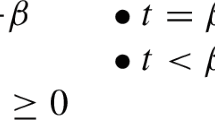Abstract
Awareness logic is a type of belief logic in which an agent's beliefs are restricted to those sentences that the agent is aware of. Awareness logic is a successful way to circumvent the problem of omniscience so that actual belief is modelled in a reasonable way. In this paper, we suggest a new method modelling awareness and actual belief by using two-dimensional logics. We show that the two-dimensional logics are flexible tools. Different types of concepts of awareness can be easily modelled by this method.
Similar content being viewed by others
REFERENCES
Bergmann, M. Presupposition and two-dimensional logic, in J. L. Garfield and M. Kiteley (eds), Meaning and Truth: The Essential Readings in Modern Semantics, Paragon House, New York, 1991, pp. 189-211.
Bergmann, M. Only, even, and clefts in two-dimensional logic, in Proceedings of the 11th Internat. Sympos. on Multiple-Valued Logic, Oklahoma 1981, Long Bench, 1981, pp. 117-123.
Fagin, R. and Halpern, J. Y. Belief, awareness and limited reasoning: Preliminary report, in Proceedings IJCAI-85, Los Angeles, CA, 1985, pp. 491-501.
Fagin, R. and Halpern, J. Y. Belief, awareness and limited reasoning, Artificial Intelligence 34 (1988), 39-76.
Fagin, R., Halpern, J. Y., Moses, Y. and Vardi, M. Y. Reasoning about Knowledge, MIT Press, 1995.
Gottwald, S. A Treatise on Many-Valued Logic, Research Studies Press, 2001.
Hintikka, J. Knowledge and Belief, Cornell University Press, Ithaca, NY, 1962.
Konolige, K. What awareness isn't: A sentential view of implicit and explicit belief, in Proceedings of the First Conference on Theoretical Aspects of Reasoning about Knowledge, 1986, pp. 241-250.
Levesque, H. Logic of implicit and explicit belief, in Proceedings of the Fourth National Conference on Artificial Intelligence (AAAI84), Menlo Park, CA, 1984,pp. 198-202.
Meyer, J.-J., Ch. and van der Hoek, W. Epistemic Logic for AI and Computer Science, Cambridge Tracts in Theoretical Computer Science, Cambridge University Press, 1995.
Moreno, A., Cortes, U. and Sales, T. Subjective situations, in Garijo and Boman (eds), Multi-Agent System Engineering, Lecture Notes in Artif. Intell. 1647, 1999, pp. 210-220.
Rantala, V. Quantified modal logic: Non-normal worlds and propositional attitudes, Studia Logica 41 (1982), 47-67.
Sim, K. M. Epistemic logic and logical omniscience: A unifying framework, Internat. J. Intelligent Systems 15 (2000), 129-152.
Thijsse, E. Partial Logic and Knowledge Representation, Eburon Publisher, 1992.
Thijsse, E. Combining partial and classic semantics: A hybrid approach to belief and awareness, in Doher (ed.), Partiality, Modality, and Nonmonotonicity, 1996, pp. 223-249.
Wansing, H. A general possible worlds framework for reasoning about knowledge and belief, Studia Logica 49 (1990), 523-539 and 50 (1991), 359.
Author information
Authors and Affiliations
Rights and permissions
About this article
Cite this article
Liu, H., Ju, S. Two-Dimensional Awareness Logics. Journal of Philosophical Logic 33, 481–495 (2004). https://doi.org/10.1023/B:LOGI.0000046141.49831.24
Issue Date:
DOI: https://doi.org/10.1023/B:LOGI.0000046141.49831.24



